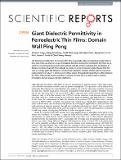Files in this item
Giant dielectric permittivity in ferroelectric thin films : domain wall ping pong
Item metadata
| dc.contributor.author | Quan Jiang, A. | |
| dc.contributor.author | Jian Meng, X. | |
| dc.contributor.author | Wei Zhang, D. | |
| dc.contributor.author | Hyuk Park, M. | |
| dc.contributor.author | Yoo, S. | |
| dc.contributor.author | Jin Kim, Y. | |
| dc.contributor.author | Scott, James Floyd | |
| dc.contributor.author | Seong Hwang, C. | |
| dc.date.accessioned | 2015-11-05T15:40:04Z | |
| dc.date.available | 2015-11-05T15:40:04Z | |
| dc.date.issued | 2015-10-06 | |
| dc.identifier | 228703425 | |
| dc.identifier | 3dd7e450-6c8d-499d-8579-1faedcf8ba65 | |
| dc.identifier | 84943311484 | |
| dc.identifier | 000362254800001 | |
| dc.identifier.citation | Quan Jiang , A , Jian Meng , X , Wei Zhang , D , Hyuk Park , M , Yoo , S , Jin Kim , Y , Scott , J F & Seong Hwang , C 2015 , ' Giant dielectric permittivity in ferroelectric thin films : domain wall ping pong ' , Scientific Reports , vol. 5 , 14618 . https://doi.org/10.1038/srep14618 | en |
| dc.identifier.issn | 2045-2322 | |
| dc.identifier.uri | https://hdl.handle.net/10023/7749 | |
| dc.description | This study was supported by the National Key Basic Research Program of China (No. 2014CB921004), the National Natural Science Foundation of China (Nos. 61225020 and 61176121), and the Program for Professor of Special Appointment (Eastern Scholar) in Shanghai. C.S.H. acknowledges the support of the Global Research Laboratory Program (2012040157) through the National Research Foundation (NRF) of Korea. Date of Acceptance: 02/09/2015 | en |
| dc.description.abstract | The dielectric permittivity in ferroelectric thin films is generally orders of magnitude smaller than in their bulk. Here, we discover a way of increasing dielectric constants in ferroelectric thin films by ca. 500% by synchronizing the pulsed switching fields with the intrinsic switching time (nucleation of domain plus forward growth from cathode to anode). In a 170-nm lead zirconate titanate thin film with an average grain size of 850' this produces a dielectric constant of 8200 with the maximum nucleus density of 3.8 μ1-2, which is one to three orders of magnitude higher than in other dielectric thin films. This permits smaller capacitors in memory devices and is a step forward in making ferroelectric domain-engineered nano-electronics. | |
| dc.format.extent | 520592 | |
| dc.language.iso | eng | |
| dc.relation.ispartof | Scientific Reports | en |
| dc.subject | QC Physics | en |
| dc.subject | NDAS | en |
| dc.subject.lcc | QC | en |
| dc.title | Giant dielectric permittivity in ferroelectric thin films : domain wall ping pong | en |
| dc.type | Journal article | en |
| dc.contributor.institution | University of St Andrews. School of Chemistry | en |
| dc.contributor.institution | University of St Andrews. School of Physics and Astronomy | en |
| dc.identifier.doi | 10.1038/srep14618 | |
| dc.description.status | Peer reviewed | en |
| dc.identifier.url | http://www.nature.com/articles/srep14618#supplementary-information | en |
This item appears in the following Collection(s)
Items in the St Andrews Research Repository are protected by copyright, with all rights reserved, unless otherwise indicated.

